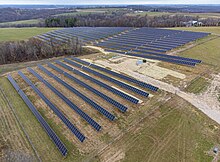Our website is made possible by displaying online advertisements to our visitors.
Please consider supporting us by disabling your ad blocker.
Community solar

A community solar project, farm or garden is a solar power installation that accepts capital from and provides output credit and tax benefits to multiple customers, including individuals, businesses, nonprofits, and other investors. Participants typically invest in or subscribe to a certain kW capacity or kWh generation of remote electrical production.[2] The project's power output is credited to investors or subscribers in proportion to their investment, with adjustments to reflect ongoing changes in capacity, technology, costs and electricity rates. Community solar benefits renters, homeowners and business owners who don’t own their own homes, don’t have a suitable roof orientation for solar or who can’t afford the upfront costs of solar.[3] Community solar provides direct access to the renewable energy to customers who cannot install it themselves.[4] Companies, cooperatives, governments or non-profits operate the systems.[5]
As of 2024, there were 44 U.S. states with at least one community solar project.[6] Only 18 states and Washington D.C. have policies and programs that encourage community solar's growth.[4]
- ^ "Partnership brings benefits of community solar to Vernon County". 25 October 2023.
- ^ "Community Solar Basics". Energy.gov. Retrieved 2021-09-17.
- ^ Metea, Rachel (16 December 2024). "New installation projects for U.S. Army, New York community solar". pv magazine.
- ^ a b Metea, Rachel. "Walmart, Nexamp to bring 31 community solar projects to five U.S. states". pv magazine.
- ^ Cite error: The named reference
kgwas invoked but never defined (see the help page). - ^ "Community Solar". www.nrel.gov. Retrieved 2021-02-18.
Previous Page Next Page


